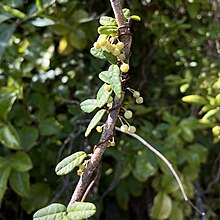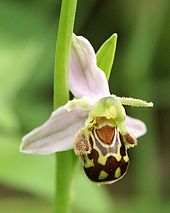Mimicry in plants

In evolutionary biology, mimicry in plants is where a plant evolves to resemble another organism physically or chemically, increasing the mimic's Darwinian fitness. Mimicry in plants has been studied far less than mimicry in animals, with fewer documented cases and peer-reviewed studies. However, it may provide protection against herbivory, or may deceptively encourage mutualists, like pollinators, to provide a service without offering a reward in return.[2]
Types of plant mimicry include Bakerian, where female flowers imitate males of the same species, Dodsonian, where a plant mimics a rewarding flower, luring pollinators by mimicking another species of flower, or fruit where feeders of the other species are attracted to a fake fruit to distribute seeds, Vavilovian, where a weed is unintentionally artificially selected to resemble a crop plant, Pouyannian, in which a flower imitates a female mate, deceiving a male pollinating insect into pseudocopulation, Batesian, where a harmless species deter predators by mimicking the characteristics of a harmful species, and leaf mimicry, where a plant resembles a nearby plant to evade the attention of herbivores.
Reproductive
[edit]Pouyannian
[edit]
In Pouyannian mimicry,[3] named after the French lawyer and amateur botanist Maurice-Alexandre Pouyanne,[4] flowers mimic a male pollinator's potential female mate, visually or with other stimuli.[5] Many orchids, including the Ophrys bee orchids, deceive male insects into pseudocopulation in this way, using them to transfer pollen.[6] For instance, the orchid Epipactis helleborine is physiologically and morphologically adapted to attract social wasps as their primary pollinators. Social wasps feed their larvae on insects such as caterpillars. To locate that prey, they use a combination of visual and olfactory cues. The flowers of E. helleborine and E. purpurata emit green-leaf volatiles attractive to foragers of the social wasps Vespula germanica and V. vulgaris. Several E. helleborine green-leaf volatiles that induced a response in the antennae of wasps were also emitted by cabbage leaves infested with caterpillars (Pieris brassicae), common prey items for wasps. Despite a large nectar reward, the species is almost entirely overlooked by other pollinators.[7]
Carrion flowers, including the enormous Amorphophallus titanum,[8] mimic the scent and appearance of rotting flesh to attract necrophagous (carrion-feeding) insects like flesh flies (Sarcophagidae), blowflies (Calliphoridae), house flies (Muscidae) and some beetles (e.g., Dermestidae and Silphidae) which search for dead animals to use as brood sites. The decaying smell of the flower comes from oligosulfides, decayed proteins that contain the amino acids methionine and cysteine. While carrion flowers do produce a small amount of nectar, this does not necessarily make their relationship to necrophagous insects mutualistic. Insects lay eggs on the carrion flowers, meaning they mistake the flowers for oviposition sites. The nectar acts as a lure to bring the insects closer to the reproductive parts of the flower.[9]
Bakerian
[edit]Bakerian mimicry, named after English naturalist Herbert Baker,[10] is a form of automimicry or intraspecific mimicry that occurs within a single species. In plants, the female flowers mimic male flowers of their own species, cheating pollinators out of a reward. This reproductive mimicry may not be readily apparent as members of the same species may still exhibit some degree of sexual dimorphism, i.e. the phenotypic difference between males and females of the same species. It is common in many species of Caricaceae, a family of flowering plants in the order Brassicales, found primarily in tropical regions of Central and South America, and Africa.[11][12]
Dodsonian
[edit]Dodsonian mimicry, named after American botanist, orchidologist, and taxonomist, Calaway H. Dodson, is a form of reproductive floral mimicry, but the model belongs to a different species than the mimic.[13] By providing similar sensory signals as the model flower, it can lure its pollinators. Like Bakerian mimics, no nectar is provided.
Epidendrum ibaguense, a species of epiphytic orchid of the genus Epidendrum that occurs in Trinidad, French Guiana, Venezuela, Colombia, and northern Brazil, resembles flowers of Lantana camara and Asclepias curassavica (commonly called Mexican butterfly weed, blood-flower, scarlet milkweed, or tropical milkweed), both are species of flowering plant with the first in the verbena family, while the latter belongs to the milkweed family, and both are native to the American tropics. Epidendrum ibaguense is pollinated by monarch butterfly (Danaus plexippus) and perhaps hummingbirds.[14] Similar cases are seen in some other species of the same family. The mimetic species may still have pollinators of its own though, for example a Lamellicorn beetle, which usually pollinates correspondingly colored Cistus flowers, is also known to aid in pollination of Ophrys species that are normally pollinated by bees.[15]
Defensive
[edit]Batesian
[edit]In Batesian mimicry, named after the English naturalist Henry Walter Bates, a harmless species has evolved to imitate the warning signals of a harmful species directed at a predator. Batesian mimicry of thorns[16] and possibly of spider webs[17] has been observed in plants.
Thorn mimicry of two types has been observed in plants. The first, a special case of intra-organismic Batesian mimicry characteristic of Aloe sp. (Liliaceae), W. filifera (Palmaceae), and dozens of species of Agave, including A. applanta, A. salmiana, and A. obscura. These plants develop thorn-like imprints or colorations on the face of their leaves due to the teeth along the margins of that leaf (or another leaf) pressing sustained indentations into the flesh of the non-spiny parts. The second type of thorn mimicry, a more classic case of Batesian mimicry, involves the pointed, colorful organs like buds, leaves and fruit of mimetic plant species that mimic aposematic colorful thorns not found anywhere else in the organism.[16]
Several plants growing in Israel, Estonia, Greece, and Japan exhibit possible spider web mimicry. Dense, white trichomes are produced on newly extended stems and leaves that deter herbivory due to predatory habit or toxicity. This may be a case of visual mimicry or perceptual exploitation. Case examples include the new buds of Onopordum from Israel, Carthamus sp. from Greece, flower heads of Arctium tomentosum from Estonia, a fledgling leaf of Tussilago farfara from Estonia, and new fronds of Osmunda japonica from Japan.[17]
Crypsis
[edit]
In ecology, crypsis is an organism's ability to avoid detection by other organisms. In cryptic mimicry, a prey organism deceives a potential predator by providing false, usually visual, signals or a lack of signals. Boquila trifoliata, a South American member of the family Lardizabalaceae, is a climbing vine with a highly variable appearance (phenotype). It is capable of mimicking the leaf features of plant species that it clings to, such as their coloration, size, and shape. By camouflaging its leaves, Boquila reduces damage from herbivorous animals.[1]
Some hundreds of species in the Mesembryanthemaceae (ice plants) of Southern Africa are camouflaged as small stones, especially Lithops, which are known as pebble plants or living stones. By appearing non-living, they are less likely to be eaten by herbivores, and in dusty dry conditions among stones are "virtually impossible to spot".[8]
In cultivation
[edit]Vavilovian
[edit]Vavilovian mimicry (also known as crop mimicry) is named after the Russian plant geneticist who identified the centres of origin of cultivated plants, Nikolai Vavilov.[18] It is a form of mimicry in plants where a weed comes to share one or more characteristics with a domesticated plant through generations of artificial selection. Selection against the weed may occur by killing a young or adult weed, separating its seeds from those of the crop (winnowing), or both. This has been done manually since Neolithic times, and in more recent years by agricultural machinery.[19]
See also
[edit]References
[edit]- ^ a b Gianoli, Ernesto; Carrasco-Urra, Fernando (2014-05-05). "Leaf Mimicry in a Climbing Plant Protects against Herbivory". Current Biology. 24 (9): 984–987. doi:10.1016/j.cub.2014.03.010. PMID 24768053.
- ^ Pannell, John R.; Farmer, Edward E. (2016-09-12). "Mimicry in plants". Current Biology. 26 (17): R784–R785. doi:10.1016/j.cub.2016.04.005. PMID 27623255.
- ^ Pasteur 1982, p. 169.
- ^ "Orchids Today and Yesterday". South Coast Orchid Society. April 2021. Retrieved 5 August 2024.
- ^ van der Pijl & Dodson 1966, pp. 129–141.
- ^ Schiestl, F. P. (2005). "On the success of a swindle: pollination by deception in orchids" (PDF). Naturwissenschaften. 92 (6): 255–264. Bibcode:2005NW.....92..255S. doi:10.1007/s00114-005-0636-y. hdl:20.500.11850/32223. PMID 15931514. S2CID 24626163.
- ^ Brodmann, Jennifer; Twele, Robert; Francke, Wittko; Hölzler, Gerald; Zhang, Qing-He; Ayasse, Manfred (2008-05-20). "Orchids Mimic Green-Leaf Volatiles to Attract Prey-Hunting Wasps for Pollination". Current Biology. 18 (10): 740–744. doi:10.1016/j.cub.2008.04.040. PMID 18472423.
- ^ a b Barrett, S. (1983). "Mimicry in Plants" (PDF). Scientific American. No. 257. pp. 76–83. Archived from the original (PDF) on 6 July 2024.
- ^ Johnson, Steven D. (2016-07-11). "Carrion flowers". Current Biology. 26 (13): R556–R558. doi:10.1016/j.cub.2015.07.047. PMID 27404246.
- ^ Barrett, S.C.H. (2001). "The Baker and Stebbins era comes to a close". Evolution. 55 (11): 2371–2374. doi:10.1554/0014-3820(2001)055[2371:tbasec]2.0.co;2.
- ^ Baker 1976, pp. 161–169.
- ^ Bawa 1980, pp. 467–474.
- ^ Dodson & Frymire 1961, pp. 133–139.
- ^ Boyden 1980, pp. 135–136.
- ^ Kullenberg 1961, pp. 1–340.
- ^ a b Lev-Yadun, Simcha (2003-09-21). "Weapon (thorn) automimicry and mimicry of aposematic colorful thorns in plants". Journal of Theoretical Biology. 224 (2): 183–188. doi:10.1016/S0022-5193(03)00156-5. PMID 12927525.
- ^ a b Yamazaki, Kazuo; Lev-Yadun, Simcha (2015-01-07). "Dense white trichome production by plants as possible mimicry of arthropod silk or fungal hyphae that deter herbivory". Journal of Theoretical Biology. 364: 1–6. doi:10.1016/j.jtbi.2014.08.045. ISSN 0022-5193. PMID 25193285.
- ^ Vavilov 1951, pp. 1–366.
- ^ Pasteur 1982, p. 169–199.
Sources
[edit]- Baker, Herbert G. (1976). ""Mistake" pollination as a reproductive system with special reference to the Caricaceae". In Burley, J. & Styles, B. T. (eds.). Tropical Trees: Variation, Breeding, and Conservation of Tropical Trees. London; New York: Academic Press for the Linnean Society of London. pp. 161–169. OCLC 2565215.
- Bawa, K. S. (May 1980). "Mimicry of Male by Female Flowers and Intrasexual Competition for Pollinators in Jacaratia dolichaula (D. Smith) Woodson (Caricaceae)". Evolution. 34 (3): 467–474. doi:10.2307/2408216. ISSN 0014-3820. JSTOR 2408216. PMID 28568703.
- Boyden, Thomas C. (January 1980). "Floral Mimicry by Epidendrum ibaguense (Orchidaceae) in Panama". Evolution. 34 (1): 135–136. doi:10.2307/2408322. ISSN 0014-3820. JSTOR 2408322. PMID 28563205.
- Dodson, Calaway H.; Frymire, G. P. (1961). "Natural Pollination of Orchids" (PDF). Missouri Botanical Garden Bulletin. 49 (9): 133–152. OCLC 604064774.
- Kullenberg, Bertil (1961). "Studies in Ophrys Pollination". Zoologiska Bidrag Från Uppsala. 34: 1–340. OCLC 7847789.
- Pasteur, Georges (1982). "A Classificatory Review of Mimicry Systems". Annual Review of Ecology and Systematics. 13: 169. doi:10.1146/annurev.es.13.110182.001125. ISSN 0066-4162.
- van der Pijl, Leendert; Dodson, Calaway H. (1966). "Chapter 11: Mimicry and Deception". Orchid Flowers: Their Pollination and Evolution. Coral Gables: University of Miami Press. pp. 129–141. ISBN 978-0-87024-069-0. OCLC 310489511.
- Vavilov, Nikolai I. (1951) [1949–1950]. "The Origin, Variation, Immunity, and Breeding of Cultivated Plants". Chronica Botanica (13). Translated by K. S. Chester: 1–366. OCLC 608036378.

